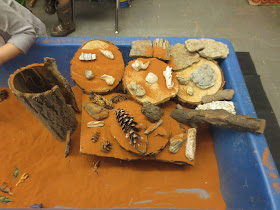This week I would like to write about how children create works of art from rocks.

 I could highlight an activity like children coloring rocks with chalk. However, I would rather empha-
I could highlight an activity like children coloring rocks with chalk. However, I would rather empha-size the rock art that emerges at the sand table which is more child-initiated and child-directed.
How does one define rock art at the sensory table? Actually, how does one define art in general? Is it something beautiful to behold? Is it something that is aesthetically pleasing? Who gets to judge?
In her book Art and Creativity in Reggio Emilia, Vea Vecchi lays the groundwork for understanding the concept we call art by writing about a sense of aesthetics or an aesthetic dimension. Interestingly, when writing about aesthetics she emphasizes something other than beauty. On page 5 she writes:
"Undoubtedly it is difficult to say simply and clearly what is meant by an aesthetic
dimension. Perhaps first and foremost it is a process of empathy relating the Self
to things and things to each other. It is like a slim thread or aspiration to quality
that makes us choose one word over another, the same for color or shade, a certain
piece of music, or mathematical formula or the taste of a food. It is an attitude of
care and attention for the things we do, a desire for meaning; it is curiosity and
wonder..."
When a child simply stacks different size rocks in the corner of the sand table, is that art?
How is he relating his Self to the rocks? As his mini-project unfolds, what makes him choose one rock over another? How is he making meaning with his actions? Maybe he is just piling rocks one-by-one as he picks them out of the sand.
When children start to create patterns using the rocks, their actions become more intentional and seem more relational. Often times, they will arrange the rocks so there is a good bit of symmetry. In the example below a child chooses rocks to fit around the circle hole. (All the rocks offered the children were gray and smooth so his only choice was size.)
Why does he make a circle? Is it simply to outline the hole? He eventually makes some meaning out of his arrangement: it becomes a pizza.
Here is another example of symmetry with rocks a child creates. In this instance, she chooses different colored rocks, but she chooses rocks of the same size to encircle one, larger rock.
Much like the previous example, this child ends up making meaning by using the rocks to enhance her role-playing: cooking. With both these examples, there is something pleasing in their symmetry, but is that enough to call it art?
When children start to combine other elements with rocks, their endeavors reach another level of complexity. Below the children are essentially in the process of creating a prehistoric diorama with Jurassic Sand, rocks, sticks and small dinosaurs.
There seems to be a rough symmetry here or, because of the intentional spacing of objects, maybe more of an organic symmetry. Most people would agree that this diorama-like arrangement looks a lot more like art with rocks.
 When more natural elements are available, children's explorations become even more complex. On the left is a typical arrangement I offer children. The picture on the right shows a child exploring the setup, which has
already gone through major changes by the children themselves.
When more natural elements are available, children's explorations become even more complex. On the left is a typical arrangement I offer children. The picture on the right shows a child exploring the setup, which has
already gone through major changes by the children themselves. Below is the third picture in this sequence. It shows the result of the child's explorations once she feels like she is done exploring.
The child combines multiple elements to make an integrated design. She uses rocks, sticks, pine cones, shells, tree cookies, a stump and some bark to make her creation. In essence, she creates a sculpture using all these natural elements. Most people would agree that this is art.
Vea Vecchi makes clear in her book that there is another important process children summon in their artistic endeavors: they create a relationship with the objects they are working with---in this case rocks. That relationship introduces them to the 'beat of life.' "This 'beat of life' is what often solicits intuitions and connections between elements to generate new creative processes" (p. 8).
If art is something more than pretty, these children have it in spades. They know rocks by handling them; by choosing which ones to work with. They know what they can do with them by exploring symmetry and by combining them with other elements. In so doing, they are tapping into their own 'beat of life'---from which all art flows.
P.S. I am a little out of my comfort zone with this post. I am not sure I know as much as I purport to know about this. I sure hope someone challenges me on this just to advance my own understanding on this topic.






I agree that what your children are doing is art. I think art is expressing yourself in way that you find meaning and pleasure. Art is communicating and that is what your young ones are doing.
ReplyDelete